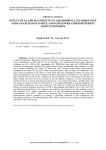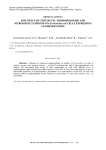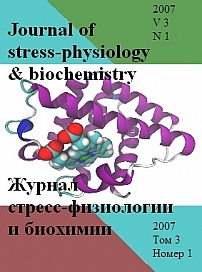1 т.3, 2007 - Журнал стресс-физиологии и биохимии
Вы можете ознакомиться с публикациями выпуска постатейно!
IDS: 14323400 Короткий адрес: https://sciup.org/14323400
Статьи выпуска 1 т.3, 2007 Журнал стресс-физиологии и биохимии

Статья обзорная
Copper (Cu) and manganese (Mn) are essential micronutrients for plants, but toxic at high concentrations. Responses of rice (Oryza sativa L.) and sunflower (Helianthus annuus L.) to toxic concentrations of Mn and Cu (up to 100 µM) were studied under three light intensities including low (LL, PPFD=100), intermediate (IL, PPFD=500) and high (HL, PPFD=800) light intensities in hydroponic medium. Rice plants showed higher susceptibility than sunflower to both heavy metals concerning dry matter of shoot and root. Growing under higher light intensity strengthened the effect of Cu toxicity while ameliorated that of Mn, the latter was attributed to the lower Mn accumulation of HL plants in both shoot and root. Chlorophyll content of leaves was influenced negatively only by Cu treatment and that at the highest concentration in the medium (100 µM). Similar with growth results, reduction of net assimilation rate (A) was higher in HL than LL plants treated by excess Cu, but in contrast to growth response, reduction was more prominent in sunflower than rice. Excess Mn-induced reduction of A was similar between LL and HL plants and was greater in sunflower than rice. Reduction of A was partly attributable to stomatal limitation, but non-stomatal mechanisms were also involved in this reduction. Copper and Mn treatment did not change the optimal quantum efficiency of PSII in dark-adapted chloroplasts (Fv/Fm ratio), but Fv/F0 was influenced particularly by Cu treatment, the reduction was higher in rice than sunflower and in HL compared to LL plants. Regarding excess Cu and Mn-mediated alterations in chlorophyll concentration, Fv/F0 and Tm values, it was suggested that, Cu and Mn toxicity depress the leaf photosynthetic capacity primarily by causing a significant alteration of the composition and functional competence of the photosynthetic units rather a reduction in the number of photosynthetic units (PSUs) per unit leaf area.
Бесплатно

Статья обзорная
Influence of expressed leghemoglobin on stability of Escherichia coli cells to reactive oxygen and nitrogen species - fert-butyl hydroperoxide and S-nitrosoglutathione was studied. We determined both action of these compounds on cells with different level of leghemoglobin expression and peroxidase activity of the cells. It was shown that priority of pro- or antioxidant properties of leghemoglobin is dependent on its concentration in the cells. In cells with reduced synthesis leghemoglobin mostly functions as prooxidant, in cells with intensive one - as antioxidant
Бесплатно


